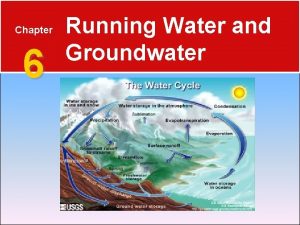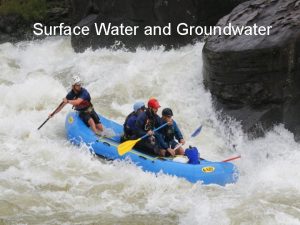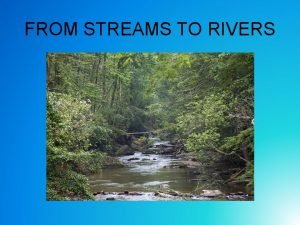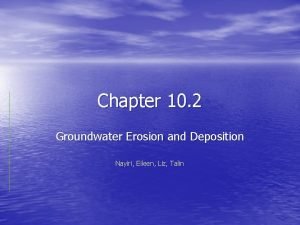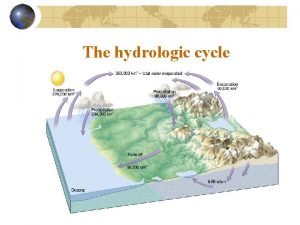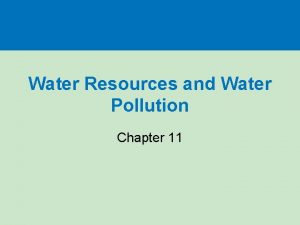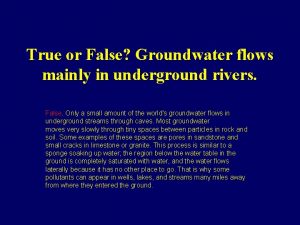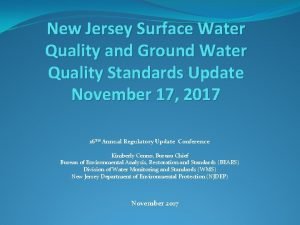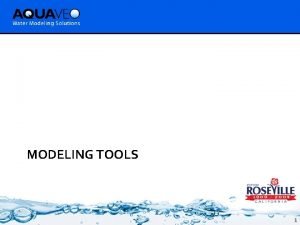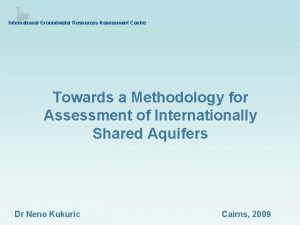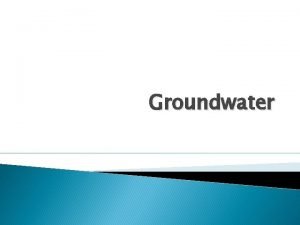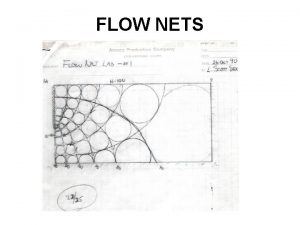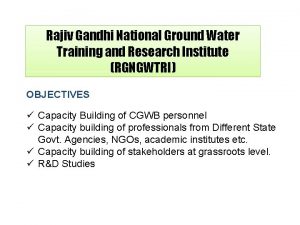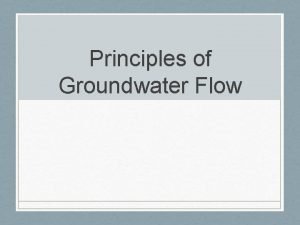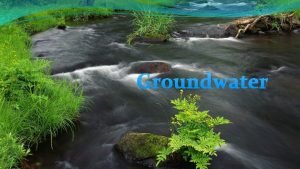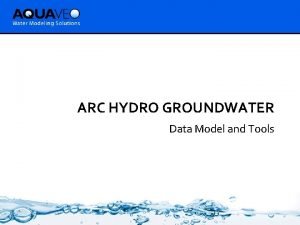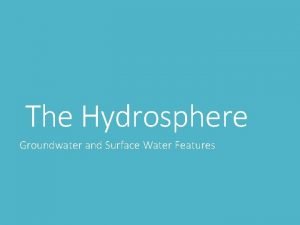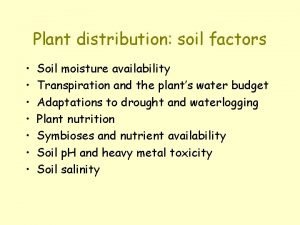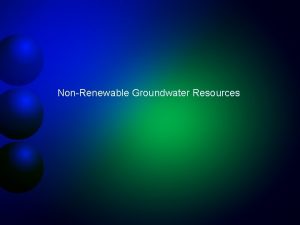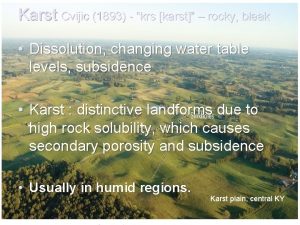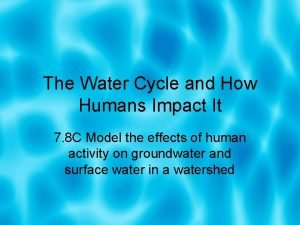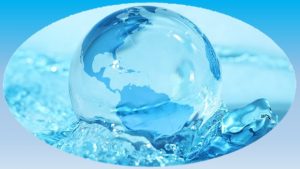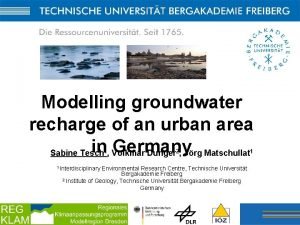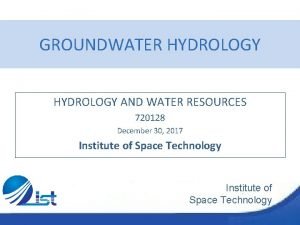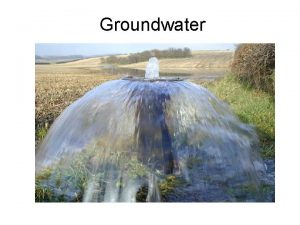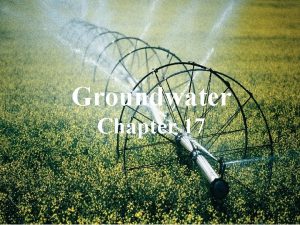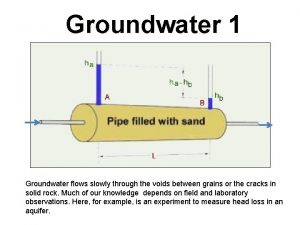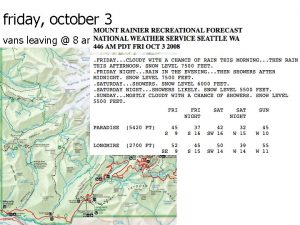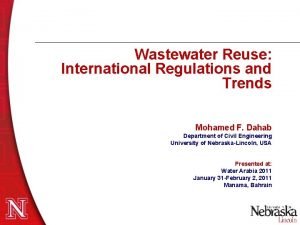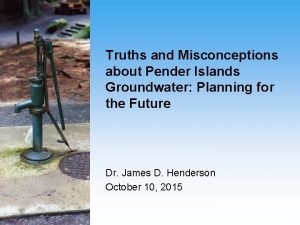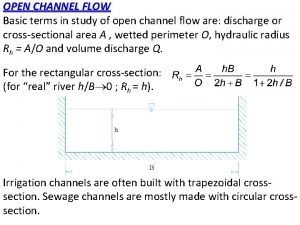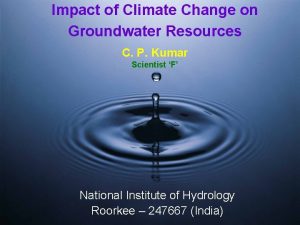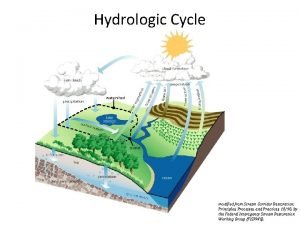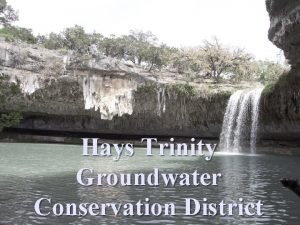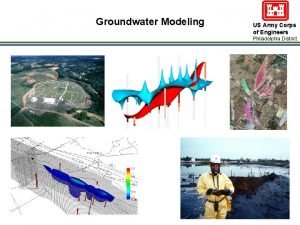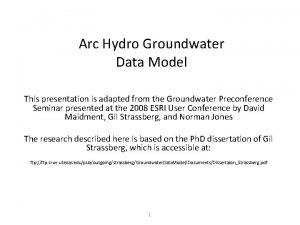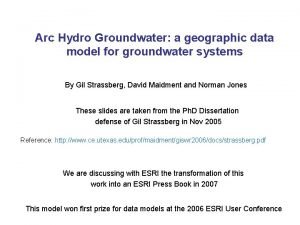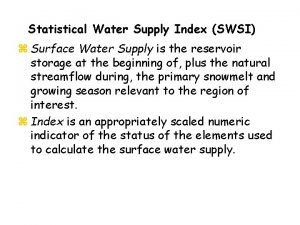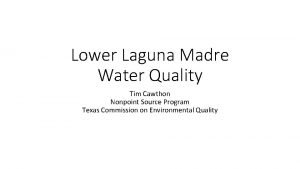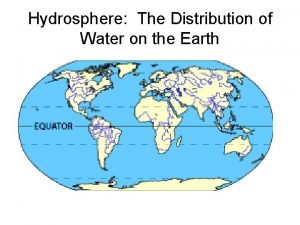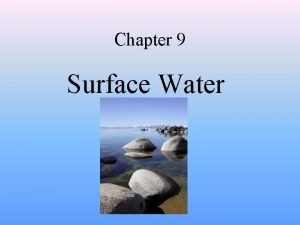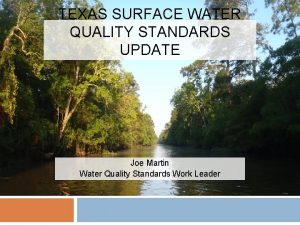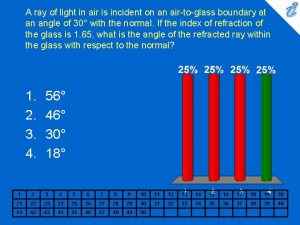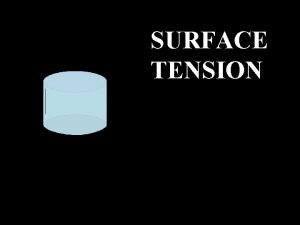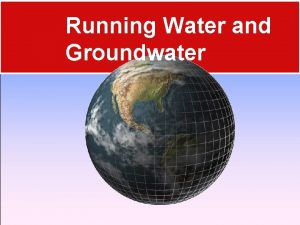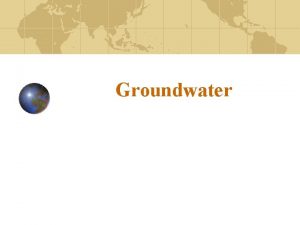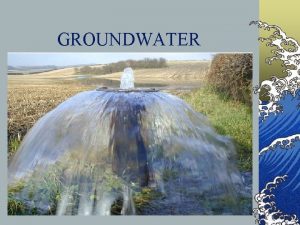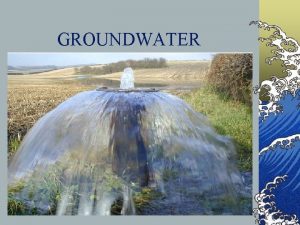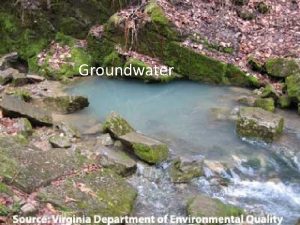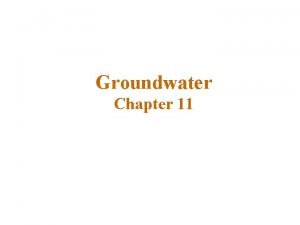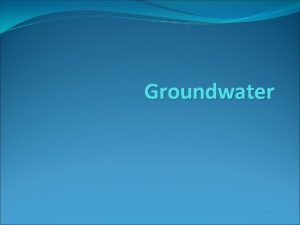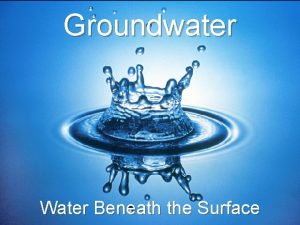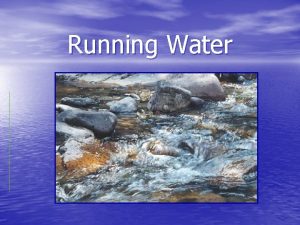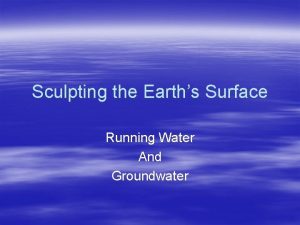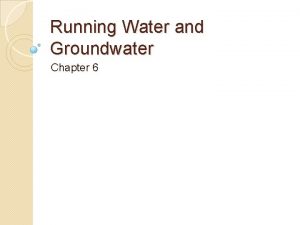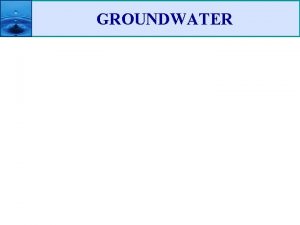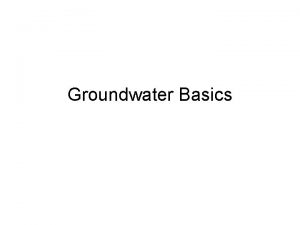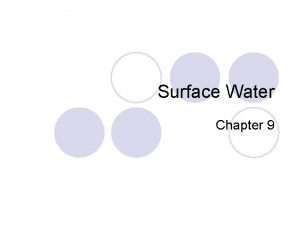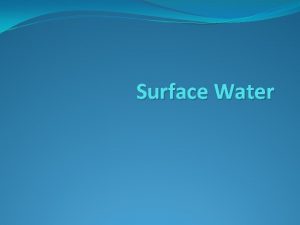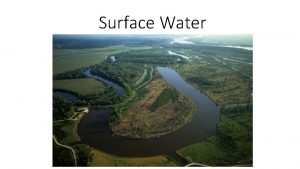Surface Running Water and Groundwater Chapter 9 10






























































- Slides: 62

Surface (Running) Water and Groundwater Chapter 9 &10 1

2

“Whiskey’s for drinking, water’s for fighting over. ” Mark Twain 3

4

The Critical Need: Water 5

6

Kibera 7

8

If a women only had to carry water for one hour a day then she could earn an additional $100 US each year. 9

Worldwide the average girl walks a minimum of 6 km (3. 5 miles) and carrying 20 liters (5. 3 gal) of water (40 lbs) several times a day. During the dry season in Viet Nam the village girls can not attend school because they have to walk 30 km each day to fetch water 10

Among adolescent girls, school attendance drops dramatically when there are no clean and safe latrines in the school. 11

12

13

14

Surface Water, Bosnia ep 15

Global Water Ocean (Salty) 97. 2 % n Fresh Water 2. 8 % n Ice 2. 15% n Liquid 0. 65% n n Groundwater 0. 62% n Lakes 0. 009% n Soil Moisture 0. 005% n Streams and Rivers 0. 001% n Atmosphere 0. 0001% 16

Why Not Use Sea Water? Desalination now provides 1% of world drinking water n Distillation (Energy intensive) n Passive distillation (Slow, inefficient) n Reverse Osmosis (Filters delicate, prone to clogging and contamination) n Towing Antarctic Icebergs (Not done yet, but the numbers are promising) n 17

Objectives Chapter 9 Objective 1: Describe the distribution of H 2 O within the Hydrosphere and the movement of H 2 O through the hydrologic cycle. Objective 2: Describe the process of stream flow and the factors influencing stream erosion, transportation, and deposition. Objective 3: Give examples illustrating the connection between landscape features and runoff including channels, stream valleys, flooding events, and drainage patterns. 18

The Hydrologic Cycle n n n Hydrologic Cycle: circulation of Earth’s water supply among the oceans, the atmosphere and the continents Powered by Sun’s energy Water is transported by: n n n Evaporation – liquid water converts to gas and rises into atmosphere from land or oceans Precipitation – gaseous water in atmosphere condenses back into liquid and drops onto land or oceans Infiltration – water from precipitation soaks into the Infiltration ground Runoff, 40 Runoff – water from precipitation flows over ground surface Groundwater Flow Transpiration – water absorbed by plants is released into the atmosphere 19 Source: http: //www. coloradocollege. edu/dept/ev/courses/EV 211 WWW/hydrological%20 cycle. jpg

The Hydrologic Cycle 20

E A B C D Use the diagram and select the appropriate letter for each term (a b c d e): 1. Source of heat energy 2. Infiltration 3. Precipitation 4. Runoff 5. Evaporation 21

True or False 6. Since the water cycle is balanced, the average annual precipitation worldwide must equal the quantity of water evaporated. 7. Water is constantly moving among the oceans, atmosphere, solid Earth, and the biosphere. Multiple Choice 8. The unending circulation of Earth's water supply is called: a. system b. hydrosphere c. renewable resource d. hydrologic cycle e. evaporation 22

9. The hydrologic cycle is primarily powered by: a. gravity b. heat c. the sun d. pressure e. all of the above 10. When the ground cannot absorb the rainfall, and it does not evaporate, the water flows over the surface into lakes and rivers as: a. glaciers b. infiltration c. Runoff d. groundwater e. condensation 23

Running Water n n Streams flow because of gravity Importance: n Streams are supplied by runoff and n Energy infiltrating groundwater. n Travel n n Runoff and groundwater come from Irrigation precipitation. n Fertile floodplains n Drainage basin: land area that contributes n Shaping of landscape (via erosion) water to a stream. n Stream: channel of flowing water of any size n Divide: imaginary line separating drainage n River – larger streams basins. n Tributaries or brooks – smaller streams 24

11. The drainage basin of one stream is separated from the drainage basin of another stream by an imaginary line called a: a. b. c. d. e. 12. Overland Separation Water Gap Drainage pattern Divide We depend on running water for: a. Energy b. transportation c. irrigation d. Most of our drinking supplies e. a, b and c f. All of the above 25

Stream Velocity n n Stream Velocity: distance water travels in given time Measured at gauging stations Stream velocity determines erosional capability Three factors affect velocity: n n n Gradient (slope) – expressed as the vertical drop of a stream over a fixed distance. High gradient = high velocity. Channel characteristics (shape, size and roughness) – more on this in next slide. Discharge (volume of water flowing per unit time) – High discharge = high velocity. Discharge also affects channel characteristics. 26

13. The dominant process in the upstream area of a river system is: a. gradient b. deposition c. erosion d. upstream e. transportation 14. The volume of water flowing past a certain point (measured in cubic feet per second) is known as: a. competence b. laminar c. discharge d. turbulent e. capacity 27

Stream Channel Characteristics n Channel shape (cross-sectional) affects velocity. n n Wide, shallow channel = slower (a lot of friction with streambed). Semicircular channel = faster (least amount of friction). Channel size: larger = faster. n Channel roughness: smoother = faster. 15. Which stream below is faster? n A B 28

Stream Valleys n Young streams demonstrate Vshaped valleys. n n n Shape results from downcutting. Rapids and waterfalls are common. Older streams begin to erode to the side more than downward, and create a floodplain. n n River is confined to channel except during flooding, when it deposits sediments. Meanders (large curves in river) and oxbow lakes are common. http: //www. geocities. com/geomwl/davis 2. gif 29

Geologic Work of Streams – Transportation of Sediment Running water is the single most important factor in shaping the Earth’s land surface. n Water carries sediments in 3 ways: n In solution (dissolved load) – mostly transported by groundwater n In suspension (suspended load) – most materials carried by streams are suspended loads n Along bottom of channel (bed load) – moves only intermittently n 30

Geologic Work of Streams – Deposition of Sediment n n Streams deposit suspended sediment when they slow down. Recall from unit on rocks: fast streams can carry larger particles, while slow streams can only carry smaller particles. Sorting: particles of similar size are deposited together Alluvium: material deposited by a stream n n Delta: deposits near the mouth of a river into a lake or ocean Alluvial fan: similar to deltas, but on land – stream deposits sediment where it empties into a plain 31

16. Most large rivers carry the largest part of their load: a. as bed load b. in solution c. near their head d. during the dry season e. in suspension 32

Objectives Chapter 10 Concept 4: Discuss the occurrence and movement of groundwater. n Concept 5: Explain unique features and environmental concerns associated with groundwater and the use of groundwater as a nonrenewable resource including: subsidence, contamination, and sinkholes. The story of groundwater video. n 33

How Much Water does it take to produce ? Answer Choices: 3 gal 6 gal 12 gal 14 gal 35 gal 65 gal 100 gal 120 gal 150 gal 1300 gal 1. A serving of almonds? 2. An orange? 3. A serving of French fries? 4. A head of lettuce? 5. A gallon of milk? 6. A serving of rice? 7. A tomato? 8. A watermelon? 9. An egg? 10. A loaf of bread? 11. A car? 12. A hamburger? 34

Answers 1. A serving of almonds? 12 gallons 2. An orange? 14 gallons 3. A serving of French fries? 6 gallons 4. A head of lettuce? 6 gallons 5. A gallon of milk? 65 gallons 6. A serving of rice? 35 gallons 7. A tomato? 3 gallons 8. A watermelon? 100 gallons 9. An egg? 120 gallons 10. A loaf of bread? 150 gallons 11. A car? 39, 000 gallons 12. A hamburger? 1300 gallons 35

Almond Blossom Almond Trees in Southern California Almonds are drupes not nuts. Drupes are stone fruits with a fleshy outer covering and a hard seed center. Like olives, nectarines, peaches, pistachios, mangos, dates, coconuts, plums and cherries. 36

How can an egg use that much water? ! 37

How much do we depend on Groundwater? 22% of all freshwater withdrawals n 37% of agricultural use (mostly for irrigation) n 37% of the public water supply withdrawals n 51% of all drinking water for the total population n 99% of drinking water for the rural population n 38

Groundwater n Groundwater: water that occupies pore spaces in sediment and rock in a zone beneath the Earth’s surface n n n Largest reservoir of fresh water available Produces caves and sinkholes Zone of Saturation: region where all the open spaces in sediment and rock are completely filled with water Water Table: upper limit of the zone of saturation Zone of Aeration: region above the water table where spaces are not completely filled 39

Groundwater Animation Watch animation 40

Groundwater Storage n Amount of water that can be stored depends on the porosity (the volume of open spaces) of a material. Well sorted alluvial deposits have high porosity. n Poorly sorted alluvial deposits have low porosity – the small particles take up the spaces between the large. Well-sorted = Poorly-sorted = high porosity low porosity n 41

Groundwater Movement n Movement of groundwater depends on the permeability (ability to transmit fluid through interconnected pores). n n Fine texture = low permeability, slow movement Coarse texture = high permeability, fast movement http: //www. dmtcalaska. org/exploration/ISU/unit 5/u 5 lesson 1. html 42

Groundwater Movement Aquitards: regions of materials with very small pore spaces (like clay) that hinder groundwater movement n Aquifers: regions of materials with large pore spaces (like sand) that are highly permeable n 43

Springs occur when the ground surface is below the water table – groundwater then flows on the surface. n Springs often occur where an aquiclude blocks the downward movement of groundwater. n Example: Thousand Springs in Idaho n 44

Wells n n Wells are drilled openings into the zone of saturation. Important freshwater source – 65% of wellwater is used for irrigation. Drawdown: lowering of the water table as water is taken from a well. Drawdown creates a cone of depression around the well (a local depression of the water table). n n Not noticeable around domestic wells. Problematic around industrial or irrigation wells – nearby shallow wells can dry up. http: //www. epa. state. il. us/water/groundwater/wellhead-protection. html 45

46

Artesian Wells Artesian Well: water rises above the level where it was tapped. n Can only occur when there is/are n An inclined aquifer where the higher side is exposed at the surface to receive water n Confining layers both above and below the aquifer keep it from moving anywhere except into the well. n http: //commons. wikimedia. org/wiki/File: Artesian_Well. png 47

Environmental Problems with Groundwater n n n Overuse can threaten supply. Land subsidence: Groundwater removal can cause ground to sink (example: San Joaquin Valley dropped almost 9 meters between 1925 and 1975). Groundwater contamination from: n n Sewage Other sources http: //www. aegweb. org/images/Geologic%20 Hazards/subsidence_Poland. jpg 48

Hot Springs and Geysers n n n Hot springs result from water that circulates deep below the surface and gets warmer (6 -9 °C or 10 -15 °F) than the average local air temperature. Source of heat: cooling igneous rock Geysers are intermittent hot springs or fountains that eject columns of water periodically. n n Occur where extensive underground chambers exist within hot igneous rock – allows pressure to build up. Example: Old Faithful in Yellowstone (erupts about every hour) 49

Geothermal Energy n n Produced by tapping naturally occurring steam and hot water below the surface. First commercial geothermal power plant in the U. S. : The Geysers, north of San Francisco n n n At peak, produced about 1800 MW (enough energy for San Francisco and Oakland) Electricity production then started to decline as the source of hot water and steam were diminished. This is not necessarily a renewable resource, and can’t provide a large percentage of the world’s power needs. 50

Geologic Work of Groundwater n n n Groundwater primarily erodes by dissolving rock (especially limestone and other more soluble rocks). Produce caverns under the water table, and carry the dissolved load away to streams. Where water drips through the caverns, it leaves deposits of the dissolved loads called dripstones. n n n Stalactites (hang from ceiling) Stalagmites (grow upward from floor) Groundwater can also cause areas that exhibit karst topography – areas of irregular terrain punctuated by many sinkholes where the limestone has dissolved away. 51

1. During periods when rain does not fall, rivers are sustained by a. runoff b. atmospheric moisture c. groundwater d. transpirated water e. evaporation 2. The great majority of hot springs and geysers in the United States are found in the a. North b. East c. South d. Midwest e. West 52

3. Whenever the water table intersects the ground surface, a natural flow of water, called a(n) ______, results. a. sinkhole b. aquitard c. geyser d. spring e. stalagmite 53

True/False 4. The term artesian is applied to any situation in which groundwater rises in a well above the level where it was initially encountered. 5. The zone in the ground where all of the open spaces in sediment and rock are completely filled with water is called the zone of aeration. 6. Groundwater represents the largest reservoir of freshwater that is readily available to humans. 7. Fertilizers improve groundwater quality providing nutrients necessary for irrigation and drinking supplies. 8. Caverns are best described as erosional features. 54

9. Permeable rock strata or sediment that can store and transmit groundwater freely are called A. none of the below B. wells C. porosities D. aquitards E. aquifers 10. The upper limit of the zone of saturation is known as: A. the water table B. the zone of aeration C. water pressure D. soil moisture E. none of the above 55

11. The percentage of the total volume of rock or sediment that consists of voids or spaces is the A. springs B. permeability C. cone of depression D. groundwater E. porosity 56

12. When the amount of water available to recharge the aquifer is significantly less than the amount being withdrawn, groundwater A. water table will rise B. is a nonrenewable resource C. is a renewable resource D. recharge rate will be high E. all of the above 57

13. A common source of pollution for many aquifers is A. highway salt B. Landfills C. septic tanks D. sewage E. all of the above 58

14. Severe examples of land subsidence, such as what happened in the San Joaquin Valley, occur as A. limestone is dissolved B. recharge rates increase C. groundwater is pumped heavily D. groundwater is polluted E. storage capacity increases 59

15. Karst topography can include a serious geologic hazard called a: A. sinkhole B. lake C. spring D. dripstone E. subsidence 60

16. _______ are intermittent hot springs and fountains in which columns of water are ejected with great force at various intervals. A. Aquitards B. Chambers C. Artesian wells D. Geysers E. none of the above 61

17. The greatest single use of pumped groundwater from wells in the United States is for: A. remediation B. industrial cooling C. hydroelectric energy D. irrigation (agriculture) 62
 Chapter 6 running water and groundwater
Chapter 6 running water and groundwater Running water and groundwater
Running water and groundwater Once upon a time there lived an old man and an old woman
Once upon a time there lived an old man and an old woman Running running running
Running running running Water and water and water water
Water and water and water water A tiny groove in soil made by flowing water
A tiny groove in soil made by flowing water How does groundwater rejoin the water cycle
How does groundwater rejoin the water cycle Chapter 9 surface water answer key
Chapter 9 surface water answer key Groundwater erosion and deposition
Groundwater erosion and deposition Types of running water
Types of running water Curved surface area and total surface area of cone
Curved surface area and total surface area of cone Lateral and total surface area formulas
Lateral and total surface area formulas Sources of groundwater pollution
Sources of groundwater pollution How we can reduce water pollution
How we can reduce water pollution True or false: groundwater can flow.
True or false: groundwater can flow. Njdep surface water quality standards
Njdep surface water quality standards Gms groundwater modeling
Gms groundwater modeling Groundwater assessment methodology
Groundwater assessment methodology Water table
Water table Septic tank contamination groundwater
Septic tank contamination groundwater Groundwater flow net
Groundwater flow net How is the carbon cycle similar to the water cycle brainpop
How is the carbon cycle similar to the water cycle brainpop Rgngwtri
Rgngwtri Hydraulic head
Hydraulic head Permeability of rocks
Permeability of rocks Arc hydro groundwater
Arc hydro groundwater Groundwater
Groundwater Lenticels
Lenticels Is groundwater renewable or nonrenewable
Is groundwater renewable or nonrenewable Karst topography
Karst topography Human impact on groundwater
Human impact on groundwater Groundwater
Groundwater Cut bank geography
Cut bank geography Groundwater system
Groundwater system Iöz
Iöz Groundwater hydrology
Groundwater hydrology Uses of surface water
Uses of surface water Hydraulic gradient
Hydraulic gradient Darcy law
Darcy law Base level river
Base level river Groundwater recharge pdf
Groundwater recharge pdf Groundwater
Groundwater Groundwater flow definition
Groundwater flow definition Piezometer groundwater
Piezometer groundwater Groundwater mining
Groundwater mining Water balance equation
Water balance equation Hays trinity gcd
Hays trinity gcd Army corps of engineers philadelphia
Army corps of engineers philadelphia Groundwater information network
Groundwater information network Arc hydro groundwater
Arc hydro groundwater Arc hydro groundwater
Arc hydro groundwater Class 8 english chapter 7 water water everywhere
Class 8 english chapter 7 water water everywhere High surface tension vs low surface tension
High surface tension vs low surface tension Dock water allowance adalah
Dock water allowance adalah Surface water supply index
Surface water supply index Tceq integrated report
Tceq integrated report Hydrosphere distribution
Hydrosphere distribution Water flowing downslope along earth's surface
Water flowing downslope along earth's surface Texas surface water quality standards
Texas surface water quality standards How does water purity affect surface tension hypothesis
How does water purity affect surface tension hypothesis A ray of light in glass is incident on a boundary with air
A ray of light in glass is incident on a boundary with air How much of the earth's surface is covered with water
How much of the earth's surface is covered with water Surface tension
Surface tension
